SUMMARY CMI
NORSPAN® Transdermal Drug Delivery System
Consumer Medicine Information (CMI) summary
The full CMI on the next page has more details. If you are worried about using this medicine, speak to your doctor or pharmacist.
WARNING: Important safety information is provided in a boxed warning in the full CMI. Read before using this medicine.
1. Why am I using NORSPAN patches?
NORSPAN Transdermal Drug Delivery System ("patches") contain the active ingredient buprenorphine. NORSPAN patches are used for the management of pain severe enough to require daily, long-term opioid treatment and for which other forms of treatment have failed or are otherwise inappropriate to provide sufficient management of pain.
For more information, see Section 1. Why am I using NORSPAN patches? in the full CMI.
2. What should I know before I use NORSPAN patches?
Do not use if you have ever had an allergic reaction to buprenorphine or any of the ingredients listed at the end of the CMI.
Talk to your doctor if you have any other medical conditions, take any other medicines, or are pregnant or plan to become pregnant or are breastfeeding.
For more information, see Section 2. What should I know before I use NORSPAN patches? in the full CMI.
3. What if I am taking other medicines?
Some medicines may interfere with NORSPAN patches and affect how it works.
A list of these medicines is in Section 3. What if I am taking other medicines? in the full CMI.
4. How do I use NORSPAN patches?
- Your doctor will tell you exactly how much to take.
- Follow the instructions given to you by your doctor or your pharmacist.
More instructions can be found in Section 4. How do I use NORSPAN patches? in the full CMI.
5. What should I know while using NORSPAN patches?
| Things you should do |
|
| Things you should not do |
|
| Driving or using machines |
|
| Drinking alcohol |
|
| Looking after your medicine |
|
For more information, see Section 5. What should I know while using NORSPAN patches? in the full CMI.
6. Are there any side effects?
NORSPAN patches may cause constipation, nausea, vomiting, dizziness, drowsiness and be habit forming if taken frequently or over long periods.
For more information, including what to do if you have any side effects, see Section 6. Are there any side effects? in the full CMI.
WARNING:
Limitations of use
NORSPAN patches should only be used when your doctor decides that other treatment options are not able to effectively manage your pain or you cannot tolerate them.
Hazardous and harmful use
NORSPAN patches pose risks of abuse, misuse and addiction which can lead to overdose and death. Your doctor will monitor you regularly during treatment.
Life threatening respiratory depression
NORSPAN patches can cause life-threatening or fatal breathing problems (slow, shallow, unusual or no breathing) even when used as recommended. These problems can occur at any time during use, but the risk is higher when first starting NORSPAN patches and after a dose increase, if you are older, or have an existing problem with your lungs. Your doctor will monitor you and change the dose as appropriate.
Use of other medicines while using NORSPAN patches
Using NORSPAN patches with other medicines that can make you feel drowsy such as sleeping tablets (e.g. benzodiazepines), other pain relievers, antihistamines, antidepressants, antipsychotics, gabapentinoids (e.g. gabapentin and pregabalin), cannabis and alcohol may result in severe drowsiness, decreased awareness, breathing problems, coma and death. Your doctor will minimise the dose and duration of use; and monitor you for signs and symptoms of breathing difficulties and sedation. You must not drink alcohol while using NORSPAN patches.
FULL CMI
NORSPAN® Transdermal Drug Delivery System
Active ingredient: buprenorphine
Consumer Medicine Information (CMI)
This leaflet provides important information about using NORSPAN patches. You should also speak to your doctor or pharmacist if you would like further information or if you have any concerns or questions about using NORSPAN patches.
Where to find information in this leaflet:
1. Why am I using NORSPAN patches?
2. What should I know before I use NORSPAN patches?
3. What if I am taking other medicines?
4. How do I use NORSPAN patches?
5. What should I know while using NORSPAN patches?
6. Are there any side effects?
7. Product details
1. Why am I using NORSPAN patches?
NORSPAN patches contain the active ingredient buprenorphine. Buprenorphine belongs to a group of medicines called opioid analgesics.
NORSPAN patches are indicated for the management of severe pain where:
- other treatment options have failed, are contraindicated, not tolerated or are otherwise inappropriate to provide sufficient management of pain, and
- the pain is opioid-responsive, and
- requires daily, continuous, long-term treatment.
2. What should I know before I use NORSPAN patches?
Warnings
Do not use NORSPAN patches if:
- you are allergic to buprenorphine, or any of the ingredients listed at the end of this leaflet. Always check the ingredients to make sure you can use this medicine.
- you have acute breathing difficulties such as bronchitis or asthma
- you have severe abdominal pain with bloating, cramps or vomiting
- you have a condition where your small bowel does not work properly
- you take medicine for depression called a 'monoamine oxidase inhibitor' or have taken any in the last two weeks
- you are pregnant or in labour.
Check with your doctor if you:
- are severely drowsy, have a reduced level of consciousness or are feeling faint or dizzy upon standing
- have heart problems or heart disease
- have low blood pressure
- have chronic lung disease
- suffer from sleep apnoea (temporarily stop breathing while you sleep)
- have just drunk a large amount of alcohol, regularly drink large amounts of alcohol or have confusion and shaking due to stopping drinking alcohol
- suffer from convulsions, fits or seizures
- have a head injury, brain tumour or increased pressure in your head
- are about to have surgery, had recent gastrointestinal surgery or have had other surgery in the last 24 hours
- have chronic liver or kidney disease
- have increased prostate size or difficulty passing urine
- have problems with your gall bladder
- have problems with or recent surgery of your bile duct
- have inflammation of the pancreas
- have adrenal glands which are not working properly
- have an underactive thyroid gland
- have a severe mental condition involving losing contact with reality or an inability to think clearly
- have an addiction or history of abuse of alcohol, opioids or other drugs.
- smoke or use tobacco products (e.g. cigarettes)
During treatment, you may be at risk of developing certain side effects. It is important you understand these risks and how to monitor for them. See additional information under Section 6. Are there any side effects?
Pregnancy and breastfeeding
Check with your doctor if you are pregnant or intend to become pregnant.
NORSPAN patches given to the mother during labour can cause breathing problems and signs of withdrawal in the newborn.
Talk to your doctor if you are breastfeeding or intend to breastfeed. Low levels of opioid analgesics have been detected in human milk.
Addiction
You can become addicted to NORSPAN patches even if you use them exactly as prescribed. NORSPAN patches may become habit forming causing mental and physical dependence. If abused, it may become less able to reduce pain.
Dependence
As with all other opioid containing products, your body may become used to you using NORSPAN patches. Taking it may result in physical dependence, even at therapeutic doses. The risk of drug dependence may vary depending on the dosage, duration of treatment and additional risk factors. Physical dependence means that you may experience withdrawal symptoms if you stop using NORSPAN patches suddenly, so it is important to use it exactly as directed by your doctor.
Tolerance
Tolerance to NORSPAN patches may develop, which means that the effect of the medicine may decrease. If this happens, more may be needed to maintain the same effect.
Opioid Use Disorder (OUD)
Before using BUPREDERMAL patches and during treatment, you should speak with your doctor about the risks and signs of OUD. If these signs occur, contact your doctor or physician.
A higher dose and longer duration of opioid treatment can increase the risk of developing opioid use disorder.
Withdrawal
Continue taking your medicine for as long as your doctor tells you. If you stop having this medicine suddenly, your pain may worsen and you may experience some or all of the following withdrawal symptoms:
- nervousness, restlessness, agitation, trouble sleeping or anxiety
- body aches, weakness or stomach cramps
- loss of appetite, nausea, vomiting or diarrhoea
- increased heart rate, breathing rate or pupil size
- watery eyes, runny nose, chills or yawning
- increased sweating.
Abuse or intentional misuse of buprenorphine may result in overdose and/or death.
3. What if I am taking other medicines?
Tell your doctor or pharmacist if you are taking any other medicines, including any medicines, vitamins or supplements that you buy without a prescription from your pharmacy, supermarket or health food shop.
Some medicines may interfere with NORSPAN patches and affect how it works.
Using NORSPAN patches with medicines that can make you feel drowsy may result in severe drowsiness, decreased awareness, breathing problems, coma and death. These medicines include:
- sleeping tablets and other sedatives (including benzodiazepines and barbiturates)
- gabapentinoids (including gabapentin and pregabalin)
- cannabis
- antihistamines
- anxiolytics
- general anaesthetics
- antiemetics
- antidepressants (including tricyclic antidepressants)
- antipsychotics (including phenothiazines)
- neuroleptics
- beta-blockers (medicines used to treat high blood pressure)
- other opioids
- alcohol.
NORSPAN patches may enhance the action of neuromuscular blocking agents (medicines used to relax muscles) and affect your breathing.
NORSPAN patches may increase the anticoagulant activity of coumarin and other anticoagulants (medicines used to prevent blood clots).
NORSPAN patches should not be used if you are taking non-selective monoamine oxidase inhibitors (MAOIs) or within 14 days of stopping such treatment.
Check with your doctor or pharmacist if you are not sure about what medicines, vitamins or supplements you are taking and if these affect NORSPAN patches.
4. How do I use NORSPAN patches?
How much to use
Different strengths of NORSPAN patches are available:
- your doctor will decide which strength is suitable to control your pain;
- during treatment, your doctor may change the patch you use to a different strength if necessary, or tell you to use a combination of up to two patches. Do not cut or divide the patch or use a higher dose than recommended.
The maximum total dose must not exceed 40 microgram/hour and you should not apply more than two patches at the same time. If one 40 microgram/hour patch is applied, no additional patches should be applied. Follow the instructions your doctor or pharmacist gives you exactly.
How to use NORSPAN patches
- Each patch is applied onto the skin and lasts for seven days.
- After seven days, remove the patch and apply a new patch to a different site.
If you begin to experience pain, tell your doctor as your dosage may have to be reviewed.
Using the patch for the first time
- The first NORSPAN patch you use may take up to three days to reach its full effect. This is because buprenorphine needs to be absorbed through the skin and then into the blood before you start to feel the effects.
- Your doctor may prescribe additional medicines to control the pain during this time.
Applying the patch
- Find a clean skin site on the upper outer arm, upper chest, upper back or the side of the chest. Do not place the patch onto skin that is red, burnt or injured.
- Make sure the site is nearly hairless and has no large scars. Remove any hair by cutting with scissors if you have to, but do not shave the chosen area as this may injure the skin.
- Apply the patch to an area of skin that is clean and dry and has not had a patch applied to it for three to four weeks. If necessary, wash the area with water only. Do not use soap, alcohol or a coarse cloth to clean. Dry the area completely after washing with water. Do not apply oils or lotions to the chosen area as this may prevent your patch from sticking properly.
- Each patch is sealed in a pouch. Just before use, cut the pouch along the dotted line with scissors. Be careful not to damage the patch with the scissors. Take out the patch. Do not use the patch if the pouch is torn or looks like it has been tampered with or the pouch seal is broken.
- The sticky side of the patch is covered by a silver backing foil. Carefully peel off the smaller portion of the scored backing foil. Try not to touch the sticky part of the patch. Press the sticky edge of the patch, which had the backing foil removed, to the edge of the chosen skin site. Peel off the remaining foil and press the patch firmly onto the skin with the palm of the hand and count slowly to 30.
- Make sure the whole patch is in contact with the skin especially around the edges. If the edges of the patch begin to peel off, they may be taped down with a suitable skin tape.
- Wash your hands with clean water when you have finished applying the patch.
Wearing the patch
You should wear the patch continuously for seven days. Bathing, showering or swimming should not affect the patch. However, it is a good idea to keep the patch dry whenever possible.
Do not expose the patch to direct heat from electric blankets, heat pads, heated water beds, heat or tanning lamps, intensive sunbathing, hot water bottles, long hot baths, saunas or hot spa baths while you are using NORSPAN patches. Direct exposure to such heat may cause an increase in the amount of buprenorphine absorbed by the skin, resulting in possible overdose and death.
External heat may also prevent the patch from sticking properly.
In the event your patch falls off before it needs changing, do not use the same patch again. Apply a new patch to a different site straight away.
If you feel the effect of the patch is too weak or too strong, talk to your doctor.
Tell your doctor if you experience skin rash while wearing the patch. Skin reaction may cause infection, your doctor will tell you what to do.
Changing the patch
Change your patch on the same day at the same time each week.
For example, if you start using your patch on Monday at 9 am, change your patch the following Monday at 9 am.
- After seven days, take the old patch off.
- Fold the used patch in half so that the sticky side stick to itself.
- Dispose of the used patch in a safe place, where children cannot reach it.
- Apply a new patch straight away to a different area of the skin, following the steps under 'Applying the patch'.
A new patch should not be applied to the same skin site for three to four weeks.
If you forget to change it
Remove the old patch and apply a new patch as soon as you remember. Also make note of the day as your usual day of changing the patch may now be different. If you are late changing your patch, your pain may return. In this case, contact your doctor.
Do not apply twice the number of patches to make up for the patch that you forgot to change on time.
Using extra patches will increase the chance of unwanted side effects.
If you are not sure what to do, ask your doctor or pharmacist.
If you have trouble remembering the day and time to change your patch, ask your pharmacist for some hints.
If you use too much NORSPAN patches (overdose)
If you think you or someone else may have used too much NORSPAN patches you should immediately:
- remove the patch(es); and
- phone the Poisons Information Centre (by calling 13 11 26), or
- contact your doctor, or
- go to the Emergency Department at your nearest hospital.
If you or someone else receive too much (overdose), and experience one or more of the symptoms below, immediately remove the patch(es) and call triple zero (000) for an ambulance. Keep the person awake by talking to them or gently shaking them every now and then. You should follow the above steps even if someone other than you have accidentally used NORSPAN patches that were prescribed for you. If someone takes an overdose, they may experience one or more of the following symptoms:
- slow, unusual or difficult breathing
- drowsiness, dizziness or unconsciousness
- slow or weak heartbeat
- nausea or vomiting
- convulsions or fits.
You should do this even if there are no signs of discomfort or poisoning.
When seeking medical attention, take this leaflet and remaining medicine with you to show the doctor. Also tell them about any other medicines or alcohol which have been taken.
5. What should I know while using NORSPAN patches?
Things you should do
Call your doctor straight away if you:
- become pregnant
- feel your pain is getting worse.
Remind any doctor or dentist or pharmacist you visit that you are using NORSPAN patches.
If you are going to have surgery, tell the surgeon or anaesthetist that you are taking this medicine.
Tell your doctor if you find that you cannot concentrate or that you feel more sleepy than normal when you start using this medicine or when the dose in increased. This feeling should wear off after a few days.
Tell your doctor if you develop a high fever. At high body temperatures, the amount of buprenorphine absorbed into the skin may increase which may increase the chance of unwanted side effects.
Tell your doctor if you suffer from nausea or vomiting when using NORSPAN patches. You doctor may prescribe some medicine to help.
Tell your doctor if using NORSPAN patches causes constipation. Your doctor can advise you about your diet, the proper use of laxatives and suitable exercise you can do to help manage this.
If the patch accidently adheres to another person (e.g. a family member sharing the same bed): remove the patch immediately, wash the area thoroughly and contact your doctor.
Be careful if you are elderly, unwell or taking other medicines. Some people may experience side effects such as unsteadiness, dizziness, drowsiness or confusion which may increase the risk of fall.
Things you should not do
The maximum total dose must not exceed 40 micrograms/hour and you should not apply more than two patches at the same time. If one 40 micrograms/hour patch is applied, no additional patches should be applied.
Do not stop using this medicine suddenly. If you stop taking NORSPAN patches suddenly, your pain may worsen and you may experience withdrawal symptoms.
Do not use NORSPAN patches to treat any other complaint unless your doctor tells you to.
Do not give this medicine to anyone else, even if they have the same condition as you.
Do not expose the patch to direct heat sources, or wear it in saunas or hot tubs and avoid intensive sunbathing.
Driving or using machines
Be careful before you drive or use any machines or tools until you know how NORSPAN patches affect you.
NORSPAN patches may cause drowsiness or impair mental and/or physical ability in some people.
Drinking alcohol
Tell your doctor if you drink alcohol.
Alcohol may make you feel more sleepy, and could increase the risk of serious side effects, such as shallow breathing with the risk of stopping breathing and loss of consciousness.
Looking after your medicine
- Store below 25°C.
Follow the instructions on the carton on how to take care of your medicine properly.
Store it in a cool dry place away from moisture, heat or sunlight; for example, do not store it:
- in the bathroom or near a sink, or
- in the car or on window sills.
Keep it where young children cannot reach it. A locked cupboard at least one-and-a-half metres above the ground is a good place to store medicines.
Getting rid of any unwanted medicine
If the medicine is damaged, you no longer need to use this medicine or it is out of date, take it to any pharmacy for safe disposal.
Do not use this medicine after the expiry date.
After removing the used patch, fold it over on itself so that the adhesive side of the patch sticks to itself, and dispose of it safely where children cannot reach it.
6. Are there any side effects?
All medicines can have side effects. If you do experience any side effects, most of them are minor and temporary. However, some side effects may need medical attention.
See the information below and, if you need to, ask your doctor or pharmacist if you have any further questions about side effects.
Less serious side effects
| Less serious side effects | What to do |
Gastrointestinal and urinary related:
| Speak to your doctor if you have any of these less serious side effects and they worry you. |
Serious side effects
| Serious side effects | What to do |
Breathing related:
| Call your doctor straight away, or go straight to the Emergency Department at your nearest hospital if you notice any of these serious side effects. |
Tell your doctor or pharmacist if you notice anything else that may be making you feel unwell.
Other side effects not listed here may occur in some people.
Reporting side effects
After you have received medical advice for any side effects you experience, you can report side effects to the Therapeutic Goods Administration online at www.tga.gov.au/reporting-problems. By reporting side effects, you can help provide more information on the safety of this medicine.
Always make sure you speak to your doctor or pharmacist before you decide to stop taking any of your medicines.
7. Product details
This medicine is only available with a doctor's prescription.
What NORSPAN patches contain
| Active ingredient (main ingredient) | Buprenorphine NORSPAN 5 patches contain a total of 5 mg buprenorphine and release buprenorphine at a rate of 5 micrograms/hour NORSPAN 10 patches contain a total of 10 mg buprenorphine and release buprenorphine at a rate of 10 micrograms/hour NORSPAN 15 patches contain a total of 15 mg buprenorphine and release buprenorphine at a rate of 15 micrograms/hour NORSPAN 20 patches contain a total of 20 mg buprenorphine and release buprenorphine at a rate of 20 micrograms/hour NORSPAN 25 patches contain a total of 25 mg buprenorphine and release buprenorphine at a rate of 25 micrograms/hour NORSPAN 30 patches contain a total of 30 mg buprenorphine and release buprenorphine at a rate of 30 micrograms/hour NORSPAN 40 patches contain a total of 40 mg buprenorphine and release buprenorphine at a rate of 40 micrograms/hour |
| Other ingredients (inactive ingredients) | Levulinic acid Oleyl oleate Povidone Duro Tak 387-2051 Duro Tak 387-2054 Polyethylene terephtalate |
Do not take this medicine if you are allergic to any of these ingredients.
What NORSPAN patches look like
NORSPAN patches are either rectangular or square with rounded corners.
Each NORSPAN patch is printed with the trade name and the strength in blue ink. Each strength is a different size. The higher the strength, the larger the size.
NORSPAN patches are supplied in cartons containing two pouches each containing a single patch.
NORSPAN 5 patches are square, beige-coloured patches (Aust R 116647).
NORSPAN 10 patches are rectangular, beige-coloured patches (Aust R 116648).
NORSPAN 15 patches are rectangular, beige-coloured patches (Aust R 217507).
NORSPAN 20 patches are square, beige-coloured patches (Aust R 116650).
NORSPAN 25 patches are rectangular, beige-coloured patches (Aust R 217508).
NORSPAN 30 patches are rectangular, beige-coloured patches (Aust R 217509).
NORSPAN 40 patches are rectangular, beige-coloured patches (Aust R 217510).
Who distributes NORSPAN patches
Mundipharma Pty Limited
ABN 87 081 322 509
10 Carrington Street
SYDNEY NSW 2000
Phone: 1800 188 009
This leaflet was prepared in June 2025.
® NORSPAN is a trade mark of MUNDIPHARMA.
Norspan-CMIv4-CCDSv15
Published by MIMS August 2025

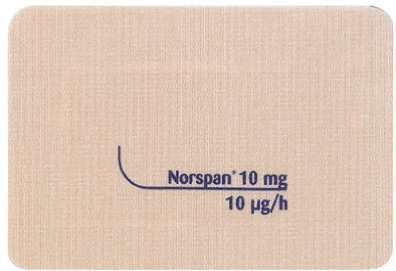
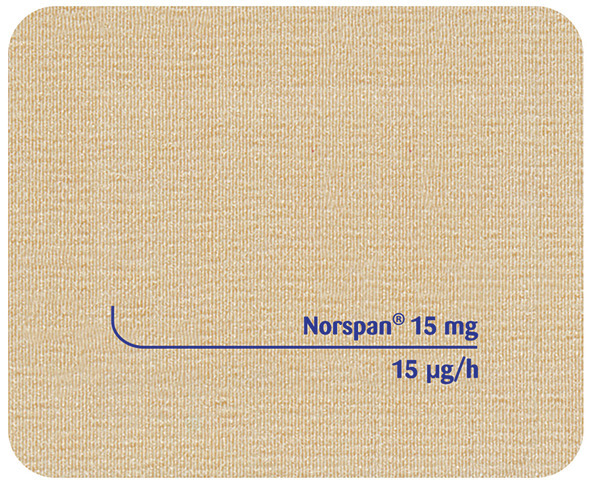
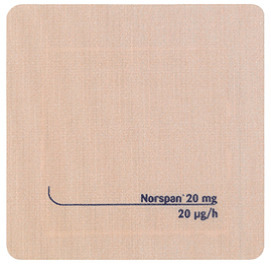
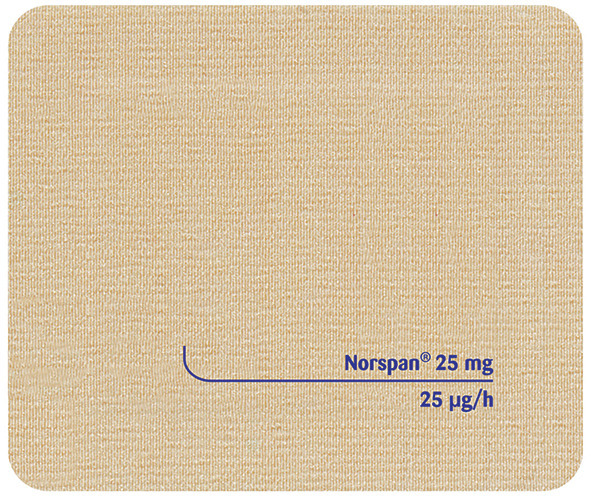
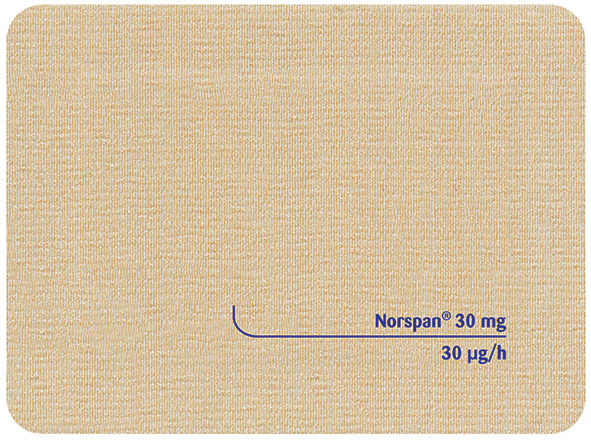
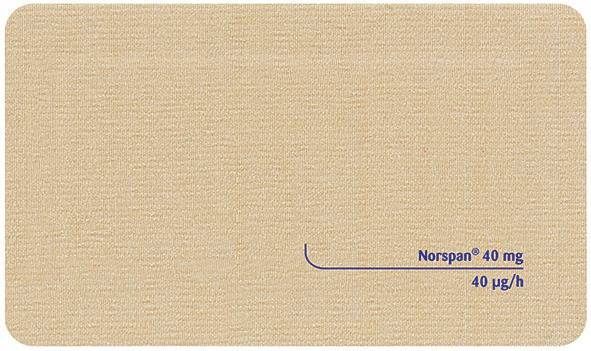
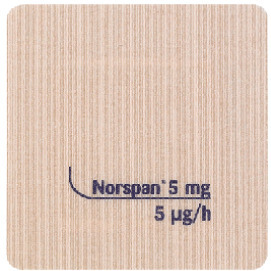

 There was no difference in escape medication usage and the incidence of discontinuation due to lack of efficacy was similar between the two treatment groups (9% Temgesic vs 14% Norspan patch). The most common adverse events reported were those commonly associated with the use of opioids (nausea, vomiting, dizziness, somnolence, headache and constipation).
There was no difference in escape medication usage and the incidence of discontinuation due to lack of efficacy was similar between the two treatment groups (9% Temgesic vs 14% Norspan patch). The most common adverse events reported were those commonly associated with the use of opioids (nausea, vomiting, dizziness, somnolence, headache and constipation). The majority of adverse events reported were mild or moderate in severity and were typically associated with opioid therapy. Withdrawals due to lack of efficacy was similar for both groups (15% for Norspan patch and 14% for hydrocodone/ paracetamol). No changes in laboratory values were considered related to treatment and no clinically important changes were reported for pulse rate, respiratory rate or physical examinations.
The majority of adverse events reported were mild or moderate in severity and were typically associated with opioid therapy. Withdrawals due to lack of efficacy was similar for both groups (15% for Norspan patch and 14% for hydrocodone/ paracetamol). No changes in laboratory values were considered related to treatment and no clinically important changes were reported for pulse rate, respiratory rate or physical examinations.
